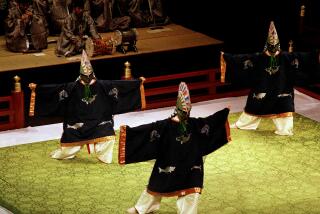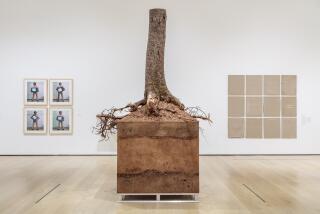Asia Pacific Performance Is a Testament to Western Freedom
- Share via
Whatever sense of primal Asian identity might be developing in the collaborative summer workshops of the Asia Pacific Performance Exchange at UCLA, the artists participating in a stimulating APPEX sampler program Thursday in Theatre 200 of the campus’ Dance Building made a collective statement about modern Western culture--its creative freedom and, particularly, its technology.
Start with their pervasive reliance on taped music and amplification: five microphones for three musicians in one piece, this in a room seating 235. Indeed, on the whole 11-part program, only “Leiteng Thang” a double-sword dance from Manipur in India--by the powerful martial artist Tombisana Rajkumar and an excerpt from the Tuong Vietnamese opera “Chau Sang” by the deft actor-singer-dancer-gymnast Ta Vu Thu showcased traditional idioms with live onstage accompaniments.
Otherwise, loudspeakers helped Tashi Dhondup launch the bounding footwork and swirling arms of his masked “Tashi Shoelpa” solo from the operatic Tibetan Lhamo repertory, and a phantom orchestra supplemented Zhang YiJuan’s falsetto singing and detailed character pantomime in the Peking Opera excerpt “Picking the Jade Bracelet.” Rajkumar, too, went electric in “Lore of the Northeast Deity,” a Manipuri spear solo in which forceful stamping periodically yielded to delicate foot-circling on the floor and in the air.
Other kinds of contrasts dominated the contemporary dance solos. Co-directed by Narumol (Kop) Thammapruksa, the work-in-progress “Eat Me” depicted Cheng-Chieh Yu’s search for identity, ricocheting between an obsessive self-scrutiny (looking at herself through empty picture frames) and bitter references to Western stereotypes of Asian culture (posing amid takeout boxes). Similarly, Eva Lee’s “Gracias a la Vida” exploited the difference between dancing inside a huge, grotesque paper-sculpture (something like a Baroque ball gown and headdress) and dancing in a body-freeing leotard. Then and now, here and there: juxtapositions to dance about.
Fusing these extremes, Sen Hea Ha’s “Kuan-Yin (Goddess of Mercy)” offered a lyric meditation on traditional concepts of grace and spirituality--the placements balletic in design but with a distinctive Korean lift to the shoulders that gave her arm positions an exquisite lightness.
APPEX postmodernism included Carol Lyn McDowell’s talking-dance “Solo for Eiko,” with Eko Supriyanto telling two stories while dancing intently, the movement punctuating the speech rather than adding any expressive component. Finally, Dan Kwong’s “The Night the Moon Landed on 39th Street” used texts, pantomime, singing and an arsenal of special effects to make a grand joke of what Kwong called “multiculturalism deluxe in orbit,”APPEX’s pan-Asian perspective comically lost in space.
Lenny Seidman, C. Jason Koontz and Uttara Coorlawala were heard in Seidman’s intricate drums-and-tanpura showpiece “Tribute to L. Shankar,” the only instrumental selection on the program. Seidman, Coorlawala, Kenny Endo and Sein Kyaw Naing also contributed expert dance accompaniments.
*
* Upcoming APPEX performances include informal collaborative programs on Aug. 11 and 12 at 7 p.m. in Theatre 200 of the Dance Building at UCLA in Westwood. Free but reservations are required and parking is $5. (310) 825-3951.
More to Read
The biggest entertainment stories
Get our big stories about Hollywood, film, television, music, arts, culture and more right in your inbox as soon as they publish.
You may occasionally receive promotional content from the Los Angeles Times.










